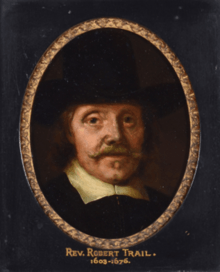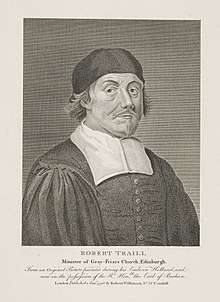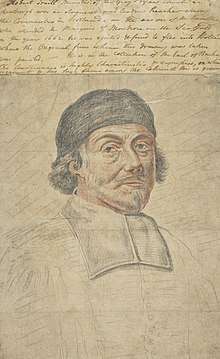Robert Traill of Greyfriars
Robert Traill of Greyfriars was born at Denino, in 1603.[2][3] He was son of Colonel James Traill, of Killcleary, Ireland, Gentleman of the Privy Chamber to Henry, Prince of Wales, and grandson of the Laird of Blebo, and Matilda Melvill of Carnbee.[4] He graduated with an M.A. from St Andrews on 21 July 1621. he went over to Paris, and subsequently joined his brother in Orleans.[2] He later studied at the Protestant College of Saumur. He was an English tutor in France to the sister of the Duke of Rohan in 1628.[5] He was afterwards teacher in a school established by a Protestant minister at Montague, in Bus Poitou.[2] He became chaplain to Archibald, Marquess of Argyll (beheaded 1661). In 1630 he returned to Scotland.[2]
Robert Traill | |
|---|---|
 | |
| Personal details | |
| Birth name | Robert Traill |
| Born | 1603 1678 |


He was ordained to Elie 17 July 1639. In 1640, he was ordered to attend Lord Lindsay's regiment at Newcastle for three months.[2] He was chaplain to the Scots army at Marston Moor in 1644. He was elected by the Town Council 7 November 1648. He became minister at Old Greyfriars on 23 March 1649.[6] In 1650 he attended the Marquess of Montrose on the scaffold. He was a protestor rather than a resolutioner.[7] He preached before Charles II. at his coronation at Scone in 1651. In 1654 he was appointed by Cromwell one of those for certifying the ability and piety of such as were fit to be admitted to the ministry in the Lothian and Border provinces. With several others he was committed to Edinburgh Castle on 23 August 1660, for engaging in a new Remonstrance, where he lay for ten months, when, having fallen sick, he was temporarily permitted to return home. He was next charged with high treason before the Privy Council, when he obliged himself, 11 December 1662, to remove from the kingdom within a month, under pain of death. John Livingstone was tried the same day.[8]
Move to Holland
Owing to tempestuous weather he experienced difficulty in finding a ship in which to sail to Holland, and the Privy Council granted him a month's further grace in which to take his departure. In a petition he states that he "is towards the age of sixty years, if not more, and so cannot weill take such a journey in such a season without evident hazard of his life" (Reg. P. C). He did make it to Holland along with other ministers and was later joined by his son Robert.[9] For some years he carried on a weekly correspondence with his friend Guthrie of Fenwick. Returning to Edinburgh, he died 12 July 1678, and was buried in Greyfriars. A portrait of him is preserved in Smith's Iconographia Scot and Pinkerton's Scottish Gallery.[10]
Family life
He married 23 December 1639, Jean (died Dec. 1680), daughter of Alexander Annand of Auchterallan, Aberdeenshire, and then Margaret Cheyne (who suffered imprisonment, June 1665, for corresponding with her husband in his exile), and had 3 sons and 3 daughters:[11]
- William, minister of Borthwick
- his second son also called Robert Traill, minister in London, and Bass Rock prisoner
- James, Lieutenant of Stirling Castle, baptised 10 March 1650, died 1721
- Helen (married Thomas Paterson, minister of Borthwick)
- Agnes, born 1646, died 1690 (married Sir James Steuart of Goodtrees, Lord Advocate)
- Margaret, born 1648, died 1717 (married James Scott of Bristo, writer in Edinburgh)[3][12]
Bibliography
- A Letter from a Father to his Children[13]
- Elie Sess.
- Edin. Comic.
- Gen. Sess. Guild, and Reg. (Rapt, and Bur.)
- Acts Pari., vii.
- Lamont's and Nicoll's Diaries
- Rutherford's and Baillie's Letters, iii.
- Peterkin's Rec.
- Wodrow's History, i., ii., and Anal. iv.
- Edin. Chr. Inst., xxiii.
- Chambers's Arm., ii.
- Wilson's Diss. Churches, i.
- Muii. Univ. Glasg.,\\.
- Steven's Scottish Church in Rotterdam
- Murray's Life of Rutherford
- Lockerby's Life of J. Brown
- Lord Guthrie's Chalmers and Trail Ancestry
- Bryce's Old Greyfriars
References
- Smith, John (1798). Iconographica Scotica. London: Robert Wilkinson. Retrieved 2 March 2019.
- Anderson, William (1877). The Scottish nation; or, The surnames, families, literature, honours, and biographical history of the people of Scotland. 3. Edinburgh [etc.] : A. Fullarton & co. pp. 574-575. Retrieved 15 April 2019.

- Scott, Hew (1915). Fasti ecclesiae scoticanae; the succession of ministers in the Church of Scotland from the reformation (Vol 1). Edinburgh: Oliver and Boyd. Retrieved 27 February 2019.

- Traill, William (1883). A Genealogical Account of the Traills of Orkney, with a Pedigree Table ... Kirkwall, Orkney: J. Calder. pp. iii–v. Retrieved 3 March 2019.
- Christie, James, ed. (1909). The records of the commissions of the general assembly of the Church of Scotland holden in Edinburgh in the years 1650-1652. 3. Edinburgh: Printed at the University Press by T. and A. Constable for the Scottish History Society. p. xix.CS1 maint: ref=harv (link)
- Bryce, William Moir; Fleming, D. Hay (1912). History of the Old Greyfriars' Church Edinburgh. Edinburgh: William Green and Sons. p. 94. Retrieved 2 March 2019.
- Christie, James, ed. (1909). The records of the commissions of the general assembly of the Church of Scotland holden in Edinburgh in the years 1650-1652. 3. Edinburgh: Printed at the University Press by T. and A. Constable for the Scottish History Society. pp. 583.CS1 maint: ref=harv (link)
- Wodrow, Robert; Burns, Robert (1828–1830). The history of the sufferings of the church of Scotland from the restoration to the revolution, with an original memoir of the author, extracts from his correspondence, and preliminary dissertation. 1. Glasgow: Blackie, Fullarton & co., and Edinburgh: A. Fullarton & co. p. 287-332. Retrieved 7 April 2019.CS1 maint: ref=harv (link) CS1 maint: date format (link)
- Steven, William (1832). The history of the Scottish church, Rotterdam. Edinburgh: Waugh & Innes, etc. p. 54. Retrieved 2 March 2019.
- Pinkerton, John; Harding, E. (1799). The Scotish gallery, or, Portraits of eminent persons of Scotland : many of them after pictures by the celebrated Jameson, at Taymouth, and other places : with brief accounts of the characters represented, and an introduction on the rise and progress of painting in Scotland. London: Printed for E. Harding ... Retrieved 3 March 2019.
- "Robert Traill of Greyfriars". The Traills - a family history. online. Retrieved 28 February 2019.
- Dunn, Samuel (1844). Memoirs of the seventy-five eminent divines : whose discourses form the morning exercises at Cripplegate, St. Giles in the fields, and in Southwark ; with an outline of a sermon from each author. London : J. Snow. pp. 164–166. Retrieved 15 April 2019.
- Johnston, John C. (1887). Treasury of the Scottish covenant. Andrew Elliot. p. 376-377.CS1 maint: ref=harv (link)